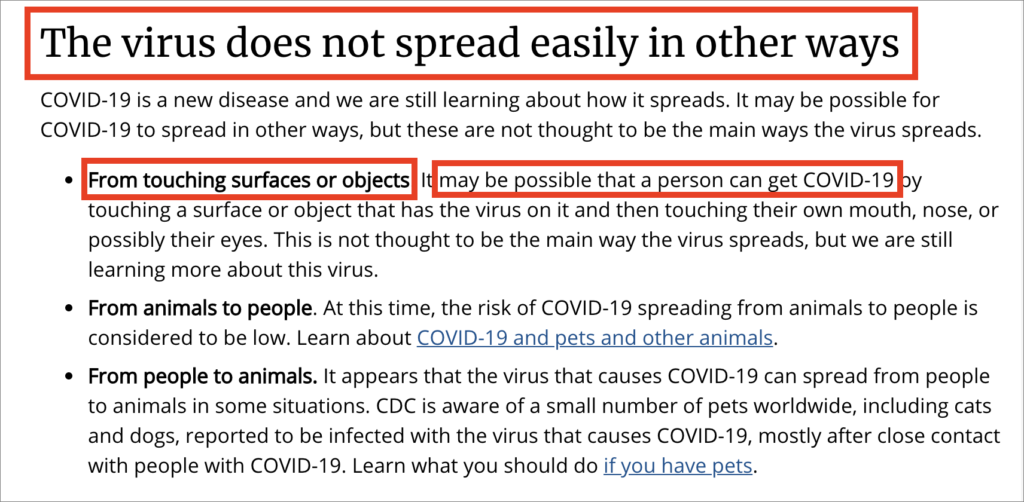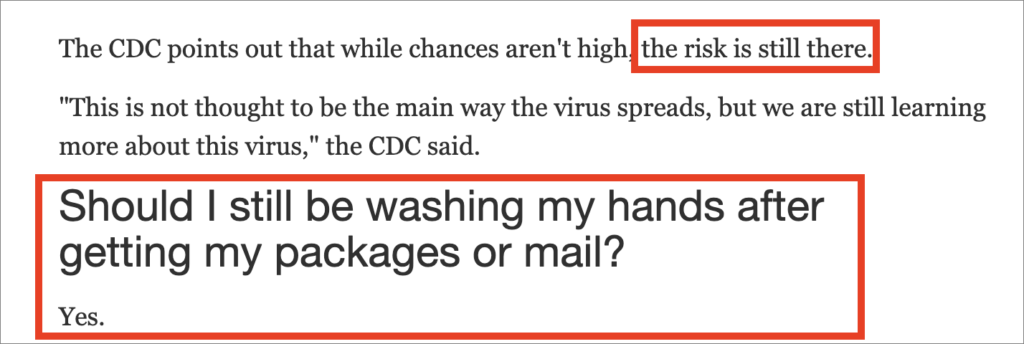Editor’s note: Between when we wrote this article and when it was scheduled to run, the CDC acknowledged that its guidelines were confusing and clarified them.
Last week, the Centers for Disease Control (CDC) began a puzzling media push to minimize the risks of catching COVID-19 from touching packages or surfaces. Information spread around the internet to the effect that the virus “doesn’t spread easily on surfaces.” Despite those headlines, the CDC’s actual recommendations didn’t change.
We’ve known since at least March that COVID-19 could live for a long time on hard surfaces. Months ago, I told you how and why to disinfect packages to protect yourself from COVID-19, citing evidence from the New England Journal of Medicine and other sources.
Our advice boils down to this:
- Don’t just skim headlines and move on. Read or at least skim the whole article.
- You should disinfect any potentially contaminated surfaces, including packages.
- You should wash and/or disinfect your hands frequently, especially after handling potentially contaminated surfaces.
The CDC created confusion around surface spread
Updated CDC guidelines feature a heading that says “The virus does not spread easily in other ways.” The top bullet point under that heading says in bold “From touching surfaces or objects.” But if you read past that bold-faced bullet point, the first thing the CDC says is “It may be possible that a person can get COVID-19 by touching a surface or object that has the virus on it and then touching their own mouth, nose, or possibly their eyes.”
What’s bizarre is that the CDC downplays the risks of surface contamination in bold, and then turns around and states that surface contamination is still a threat.

Unfortunately, the CDC’s mixed messaging has caused a number of misleading headlines, like this USA Today article about the guidelines. The headline says in bold “The CDC says coronavirus ‘does not spread easily’ on surfaces or objects. Here’s what we know.”
(Disclaimer: I have contributed to USA Today in the past.)
But scroll down deeper into the article. “The CDC points out that while chances aren’t high, the risk is still there,” the article reads later. Then, the author recommends washing your hands after touching packages and mail. So, it still seems like surface contamination is a threat.
Or, here’s a news item from KTLA 5 titled, “CDC now says the coronavirus does not spread easily from touching surfaces or objects.” Again, if you don’t watch the video, you could easily get the impression that packages aren’t potentially dangerous and you’re a nutcase for hosing them down with bleach. Thankfully, the hosts at KLTA 5 are skeptical, and they point out how terribly inconsistent the messaging around COVID-19 has been. But you have to watch the whole video to understand that.
So, what are the facts?
It’s hard to know what to believe anymore. If you feel confused, we don’t blame you. The science around COVID-19 is fast-moving and shaky, and the authorities haven’t always been forthright with the public.
Here’s what we currently understand about COVID-19 and surfaces:
- Surface contamination has never been cited as the main transmission vector. Person-to-person transmission through water droplets and the air has always been the biggest risk. That was true in March and it’s just as true now. What the CDC is saying isn’t new.
- The New England Journal of Medicine states that the virus can survive on surfaces for up to 72 hours. No one has disputed this.
- The CDC still recommends frequent hand-washing and disinfection of surfaces.
There’s also the fact that there are reports of people largely staying home and getting infected anyway. There are a few possibilities:
- They or someone in their household is interacting with outsiders, like delivery people.
- They’re lying, and as Dr. House liked to say, “Everybody lies.”
- The virus is spreading through the sewer system.
- They’re picking up the virus from contaminated surfaces, like packages.
It’s true that there’s a lot about this virus we don’t understand. And until we understand more, the wise thing to do is to err on the side of caution.
More: Getting takeout from a restaurant without catching COVID-19
The important thing as we continue through this pandemic is that you not be fooled by misleading headlines. We recommend you protect yourself by doing the following:
- Maintain social distancing as much as possible.
- Wear a mask when around people outside your household.
- Disinfect frequently touched surfaces and surfaces handled by people outside your household. Like mail and packages. This is the CDC’s own advice.
- Wash and/or disinfect your hands frequently, especially after touching potentially contaminated surfaces. Again, this is the CDC’s own advice.



You are reporting the comment """ by on